Reported infections in the U.K. have suddenly spiked in the last three days, up from 59,610 on Tuesday to 78,610 on Wednesday, 88,376 on Thursday and 93,045 on Friday.
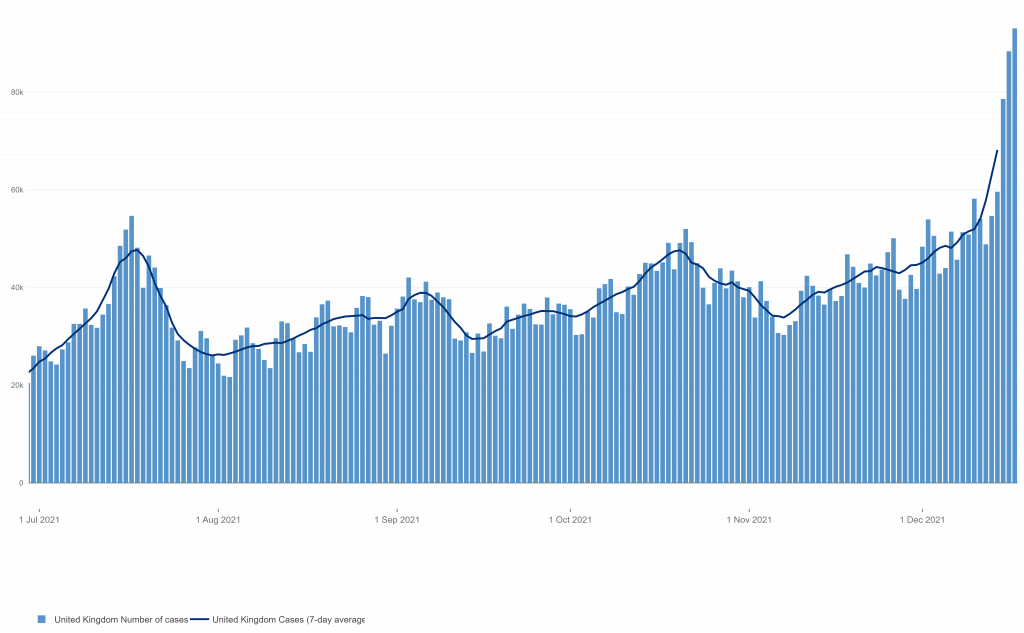
Looking at the data regionally, the spike is currently much more pronounced in London, the South East, the East of England, the East Midlands and the North West than it is in the North East, Yorkshire and the Humber, the South West and the West Midlands.

It’s not clear at this point if it is going to continue to rise, though the last three days’ counts don’t appear to indicate continued sharp growth.
It is also so far largely an artefact of massively increased testing, as the graph above with data for the U.K. up to December 16th shows.
Similar is true for Scotland. Positive tests have spiked.

But positivity is up only a little due to the large increase in testing.
How significant is it that the spike began on Monday December 13th, the day after Boris Johnson’s Sunday press conference when he warned everyone about Omicron and told them to get their booster jab? There was a huge surge in demand for booster doses starting that Monday and continuing throughout the week. Could the fact that this surge coincided with a similar surge in both testing and positive tests be more than coincidence? Perhaps people got tested before getting their booster, or just because of the dire warning of a new threat.
We would normally expect a spike in winter viral illness at this point in December, so there is nothing particularly unusual about it. In this regard, it’s worth noting that the Covid deaths trend for the U.K. is currently very similar to normal winter flu deaths at this time of year.
However, the recent announcement of the Omicron variant raises the question of the role it might be playing in the surge.
UKHSA has begun publishing a daily Omicron update. Friday’s shows a sharp increase since December 6th in the percentage of positive PCR tests with both S-gene dropout (SGTF, in purple below) and low Ct (under 30), interpreted as Omicron, reaching a majority of low-Ct PCR positives in England on December 14th at 54.2%.

In London it hit 80.8%.
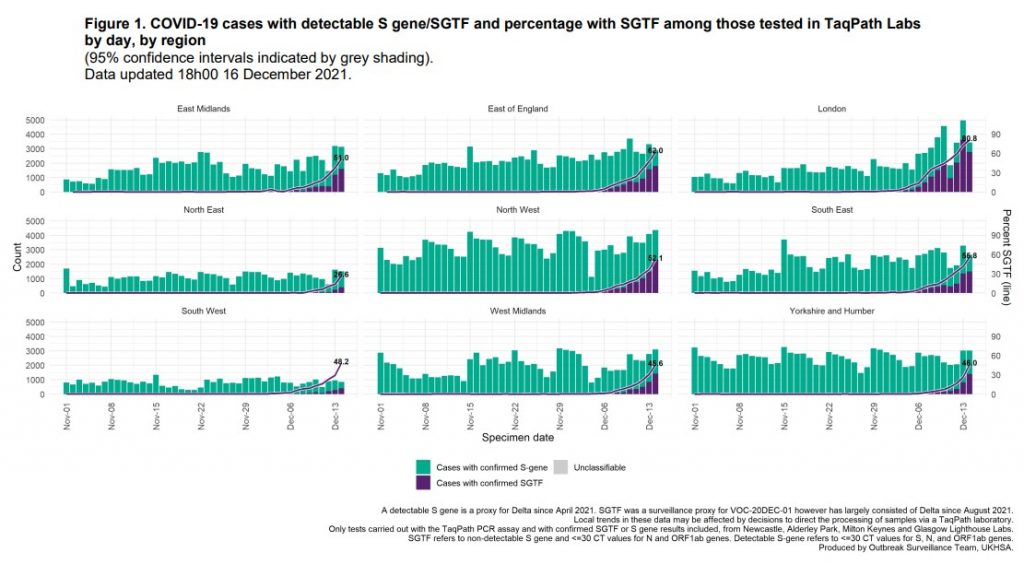
Note, however, that the sample of low-Ct PCR positives used for this data will not be representative of the wider positives from the same day. Consider December 13th, the day the spike began, with reported infections in London (by specimen date) doubling literally overnight from around 10,000 on the 12th to around 20,000 on the 13th. The above chart shows that of these 20,000 positive tests, only about 5,000, or a quarter, were PCR positives with Ct under 30, and so able to show S-gene either present or absent. The other three quarters were either PCR positives with Ct over 30, so very unlikely to be infectious and possibly false positives, or LFT positives. We aren’t told the breakdown of these test types for London, but nationally around three quarters of positives came from PCR tests on that day and a quarter came from LFTs. This gives an approximate breakdown for December 13th in London of 5,000 low-Ct PCR positives, 10,000 high-Ct PCR positives and 5,000 LFT positives. With around two thirds of PCR positives having high-Ct above 30 (so low infectiousness), this may be an indication that the spike is being driven by a lot of people getting tested just over 10 days ahead of Christmas, ‘just in case’.
While Omicron (or at least S-gene dropout) was found to be 74% of the 5,000 high-Ct PCR positives in London on December 13th, it is very unlikely to be anything like 74% of the other 15,000 positives from that day, as Omicron is a new fast-spreading infection so the large majority of its positives will be low-Ct. This means we can’t assume that 74% of all 20,000 positive test samples in London that day were Omicron, just because 74% of the quarter of positive samples that were low-Ct PCR positives were Omicron. In other words, 74% is likely a large overestimate of the proportion of London positive tests on December 13th that were Omicron.
Along with the large increase in testing at the same time, this suggests the impact of Omicron on the real infection rate is being significantly exaggerated in the raw data. A more accurate picture would probably show Omicron in the process of quickly replacing Delta while also causing a modest seasonal spike in infections, as seen in the positivity rate, but not something as dramatic as the raw positive test data suggests.
How long will the Omicron winter spike last? There is some evidence it might be peaking already. The graph below shows Omicron samples by region and per day that have been confirmed by genomic sequencing (a subset of the S-gene dropout samples from the graph above).
Note the sharp drop in numbers in London and the South East from December 12th. If this is in any way representative of the real viral incidence (and the way the graph is presented as an “epidemiology curve” suggests it should be, though it is possible it is misleading in that regard) then it shows an outbreak already running out of steam in London and the South East.
Is this a bit optimistic? Not necessarily. The latest data from South Africa also shows a slowing outbreak. Here is daily reported infection data from the original epicentre in Gauteng province.
And here’s the positivity rate nationally.
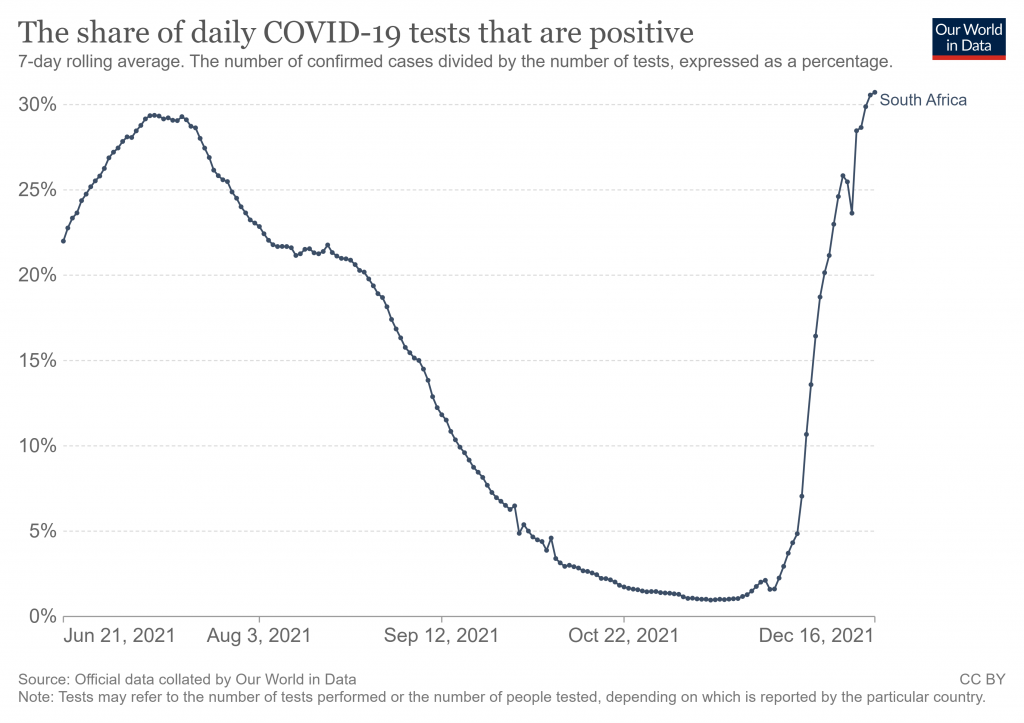
The South African Government is itself reporting that the outbreak is slowing, and also that the hospitalisation rate is currently running at less than a tenth of the hospitalisation rate of Delta at the same point in the epidemic, 1.7% versus 19%. Bloomberg reports:
South Africa delivered some positive news on the Omicron coronavirus variant on Friday, reporting a much lower rate of hospital admissions and signs that the wave of infections may be peaking.
Only 1.7% of identified COVID-19 cases were admitted to hospital in the second week of infections in the fourth wave, compared with 19% in the same week of the third Delta-driven wave, South African Health Minister Joe Phaahla said at a press conference.
One possibility is that Omicron represents SARS-CoV-2’s transition to join its fellow coronaviruses as a cause of the common cold. That’s the golden scenario, and it’s not looking impossible right now.
Even if that’s getting ahead of ourselves, it’s clear that we are over-reacting to Omicron and need to dial down the panic before we ruin another Christmas.
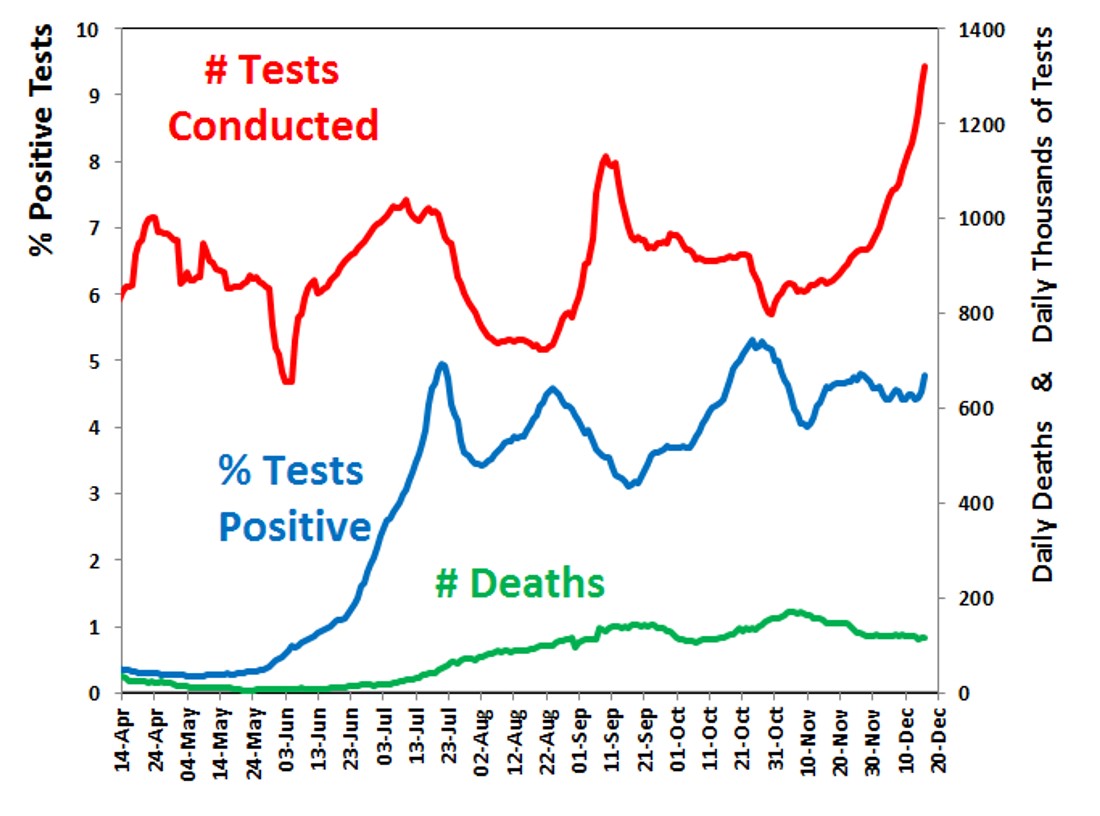
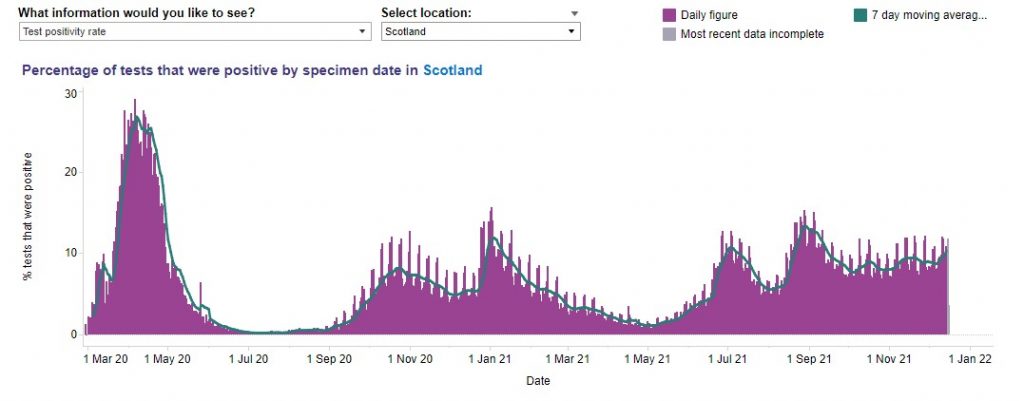
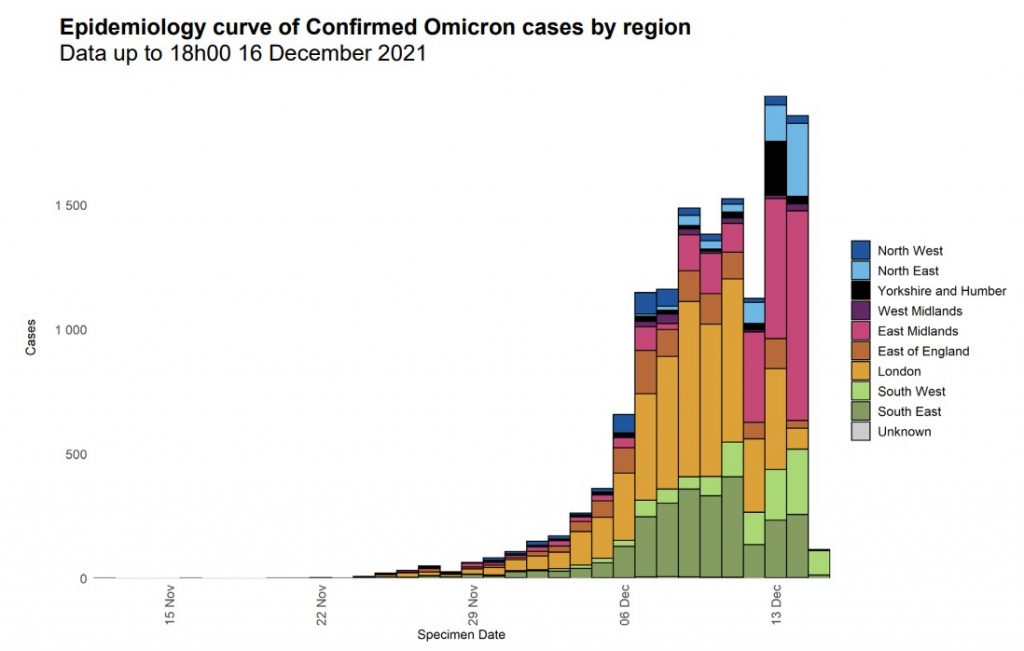












To join in with the discussion please make a donation to The Daily Sceptic.
Profanity and abuse will be removed and may lead to a permanent ban.
It’s weird. I keep seeing all these people falling ill in the crowd at football and needing treatment for chest pains. I also know anecdotally of a couple of otherwise perfectly healthy blokes who have had heart attacks this past year.
Global warming?
Russian disinformation, or camera trickery. If not climate change, that is.
Or Trump – he’s making a come-back.
He never went away!
I had a cousin who died, he was a very strong 42 year old, minor health issue, dead within days.
The lists get longer every day – never mind the BBC can avoid it all!
excessive straining whilst fluffing duvet covers; breathing in cold air when exercising outdoors after being in lockdown; “long covid”
these are actual excuses I’ve read/heard on MSM
Sunshine causes VAIDs – (new WHO ‘study’ sponsored by Gates!)
Irony intended .. but then truth is now stranger than fiction and obscene amounts of money in the hands of an individual can buy whatever you want!
I hear opening the oven door to check on the casserole can put a huge strain on the heart.
Unfortunately two people where I work have suddenly died of heart attacks. There have been more previously…
Time to keep lists and watch them grow!
Temperatures at 18 degrees centigrade? Must be ‘heat stroke’ brought on by excess Carbon in the atmosphere!
Or perhaps a non-Vegan mealy-worm diet?
No they were shaking out their duvets too vigorously, or overstressed by the sharp blast of a referee’s whistle.
Wouldn’t it be great if there was some sort of professional body representing cardiologists who could make some sort of professional pronouncement on the public concern about an anecdotal seemingly exponential rise in heart problems? I know, it’s a lot to ask for. Maybe it would allay public concern that we’ve been lied to for decades by healthcare professionals and their paymasters. (Cough – Nadal – new balls please)
Booster, kids?
Hmmm. I don’t think asking cardiologists to back your conspiracy theories is going to work.
No, they’re all too busy inserting unnecessary stents at vast cost to the public to be bothered to reply.
Is it actually a thing or just the current vogue for everyone demonstrating how much they care by getting matches stopped whilst medics attend? I’m pretty sure people having a bad turn in a sports crowd is nothing new but previously they would have been dealt with without the need for attention being drawn to every situation.
Yeah, exactly the same with all the athletes and officials dropping like sacks of spuds. It happened all the time before but no one noticed because they dragged the bodies off by the short hairs whilst play continued.
It’s Vladamir Putin carrying out chemical attacks.
He is putting heart attack poison in some of the half time pies, a BBC journalist saw him do it and everything.
Go and consider how many people-hours are involved with watching football matches in the UK, each week. Then consider what the background risk of a typical football watcher having a heart attack in the course of a year. You can then do some calculations to relate it to the time spent in at the match. You will there is a surprisingly high expected number of heart attacks.
If you analyse properly, the anecdotal rubbish is not significant.
People are just taking advantage of your lack of critical thinking skills, to fool you.
I’ve been watching football for nearly sixty years and have never seen anything like this. So stop with the gaslighting already, we know who the fools are.
because its only about old frail people, I suspect the differences may be rather minor policy differences about care homes. we purposely infected ours – germany may have protected theirs.
we have burned through some dry tinder – germany will have built some up. QALYs lost may be similar.
% excess deaths will also naturally tend to converge as the timescale increases. the remaining differences will be in how we predict the baseline for deaths over which the excess is calculated. Our World in Data just uses past deaths for the baseline. When age structure etc is included (as was done by the ONS), they found Sweden had zero excess deaths (actually slightly negative).
We haven’t really had a pandemic. Old people die in droves and those deaths are rather ‘lumpy’ year to year – given flu, colds going round. This was a nasty cold that finished off some old people but was rather irrelevant for the rest of the population.
+vax deaths.
I have a client in his 80’s, 3 of his 4 adult children had severe AE to the Pfizer vax, one is dead, 2 are in induced comas, and it’s not looking good for them, his other son and himself had moderna had no effects.
Footballers, and sportstars dropping left and right arn’t old people.
Has anyone thought of starting a daily head count on this site – the numbers are shooting up!
I wonder what figure has to be reached before they attract the attention of the BBC?
How could you? What would you count? Just press reports, just sports starts, fiddled ONS data?
Hugotalks does “Young hearts” videos, collating some of the media reports, no idea what the toal is but he’s up to part 14 currently
https://brandnewtube.com/watch/young-hearts-part-14-jab-deaths-continue-distractions-look-at-the-war-forget-the-poison_J3QlX1buI7pGQd2.html
Just counting at all – rather than ignoring- would be a good start
You suggesting that there should be a total collated for completely non-confirmed claims?
And you have the nerve to complain about MSM?
Why would I talk to you?
If you don’t talk sense, I would rather you didn’t.
if only there’s been autopsiess, where there were, in Germany, vax was confirmed.
In any normal investigationof deaths with a new pharmacutical product still under emergency use authoorisation, there would have been autopsies for every death, but thats part of the underreporting issues you refuse to recognise. Stopp trolling you have zero credibility here.
Covid seems to like killing frail older people, whereas the vaxxes seem to prefer to see off the young and healthy.
Your client will still vote for the same party that is killing his children.
Nothing changes.
A proper analysis requires consideration of such matters as availability of ICU beds/capita and a raft of other factors.
The problem with all the analyses is the appalling quality of COVID test data – something that has been pointed out time and again.
If old people weren’t frail before the vaccinations, they surely will be after!
Hancock down the Midazolam Cash and Carry. It’s two for one – could never resist a bargain!
There has been a ‘wave’ of the word ‘anecdotally’ that has lasted a whole year.
Two years. Anecdotal aka computer modelling or PCR Testing, or if it involves Government or Expert… lie.
Has it been rising ‘exponentially’?
The level of reason on this site has been falling exponentially.
only on your posts
It has since you started posting.
The Year of the Anecdowave…
The year of cumulative coincidence?
Unfortunately, nowhere can we compare apples for apples. By design. The entire COVID edifice had to be constructed by malleable statistics and mistruths in order to fully keep control of the narrative. If any truth were allowed to creep in to the official narrative it would be impossible to fully steer. The realtively insignificant <0.1% IFR alone would have rendered the episode DOA, if you’ll pardon the pun.
“It could be culture or pre-existing immunity”
Or unpopular international destinations that receive fewer travellers. Or pre-existing health; increased anxiety and slashed healthcare availability would see greater numbers of dead in places with greater ill-health metrics.
“On the other hand, the vaccines don’t seem to be as effective at preventing death as originally claimed”
Top scepticing there Noah.
“The main thing to notice is that the lines diverge massively around the time of the first wave, and then gradually converge over the following two years”
But we now know that in the first wave up to half of the care home deaths tested negative and may have had COVID attributed by anonymous zoom consultation. This would drastically lower the first wave.
Will we ever get stats on the deaths due to the NPIs? Will we ever revert to a COVID death count using deaths exclusively FROM Sars-Cov-2? Will anyone care to look?
That’s unlikely to explain Bulgaria, then.
‘“It could be culture or pre-existing immunity”
Culture has long been known as an effective preventative and in many cases cure for disease.
2021-10-25 ::: Nature of the COVID-era public health disaster in the USA, from all-cause mortality and socio-geo-economic and climatic data
https://denisrancourt.ca/entries.php?id=107&name=2021_10_25_nature_of_the_covid_era_public_health_disaster_in_the_usa_from_all_cause_mortality_and_socio_geo_economic_and_climatic_data
‘… a new respiratory disease virus for which there is no prior natural immunity in the population.’
It’s not ‘new’, it’s one of a group called coronavirus, which have been around since God was a schoolboy and are responsible for 10% of Colds.
We do not have prior natural immunity nor effective vaccines to any respiratory viruses: influenza, parainfluenza, adenovirus, rhinovirus, coronavirus, for example, which is why people get these in huge numbers every year and why we each get them repeatedly.
It’s the nature of these virus – rapid, diverse mutation which confounds our immune system and vaccines when we encounter evolved versions.
We knew this until March 2020.
The chart below shows deaths in the USA. It doesn’t look like the vaccines made much difference.
Looks like they made a difference in the negative direction to me!
.
When are we going to accept the vaccines don’t work, and are in fact killing a number of people?
There seems to be a genetic element to the negative effects, or the AE’s would be evenly spread. How much midazolam did Bulgaria brun though, what are the treatment regimes in Bulgaria?
“A number….a constantly increasing number …of people!”
How do you explain the low death rate wrt infection rates, post vaccination?
The “low” death rate wrt infection was lower before the vaccination, if we back out midazolam euthenasia. Stop trolling, nobody takes you seriously anyway.
I would be interested to know why Peru’s death figures are so much worse than elsewhere.
Obviously all the statistics are only as truthful as respective Guvmints permit.
Look at China’s, for a laugh.
Must be the Cocaine in the air!
Didn’t Peru have hideously draconian lockdowns?
yes, they were the poster-child for “lockdown fast, long and hard”. Naturally the press quietly forgot about them after their deaths shot up.
Ep.43 ‘Too Stupid To Browse The Web’
Online Harms Bill
The End of SAGE (plus a great song!)
Ukraine Crisis and EU ‘Funding’
Mad Green policies
Ep.44 ‘Inside Ukraine w/Tanya Shelepko
We catch up with Tanya
This article seems to come from another parallel ‘Fast Asleep’ world- reality has moved on from the “official narrative” and these kind of pointless graphs based on more rigged stats and pointless speculation about the ‘deadly ‘virus .
It’s not the virus – it’s the vaccines you ought to be worrying about.
The truth is bursting out around the world – but still the Pharma apologists, the Deep State, the Davos operatives, in every world Government, the Crazy Gates apologists for the madman’s Vaccinemania and warnings of new planned horrors for humaity, our entire discredited Government and soporific Parliament, the craven sold -out BBC ( more the BPC where P = propaganda) and the poor sheep, still sucking it all up and dreaming in their fantasy world!
“It’s the vaccines …stupid!” They still fiddle round with the figure, ban life-saving ivermectin and force believe in the demonstrably fake PCR tests – what more do we need to know about their dark intentions?
Toby needs to catch up with “The Conservative Woman” – or lose the race in the credibility stakes.
You sum it up nicely here:
It’s not the virus – it’s the vaccines you ought to be worrying about.
Plus MHRA JCVI etc still attempting to get them into the arms of children.
Yes, I find the abuse of children by those ‘only obeying Government Orders” obscene – a “Crime Against Humanity”. This takes us straight back to 1946.
Those ordinary Germans just obeying government instructions ended in other ordinary Germans being cattle-trucked away for the public good.
Be interesting if there was a QALY excess graph?
It might spike after the clot shots started being jabbed into arms.
Given that nobody actually knows how many died of CoVid, and that nearly all who did die would have died in under a year anyway of existing condition or hastened by some other opportunistic infection, trying to torture the raw data to reach some sort of definitive conclusion is, as they say up North, just working yourself.
But if we are to play. Left out of the surmising is the so-called ‘dry tinder’ effect. Sweden had two prior years of low all cause mortality, this built up a cohort of elderly people most susceptible to CoVid and reactions to it. Sweden’s neighbours however had had higher mortality in preceding years meaning less ‘dry tinder’ and they had smaller care homes.
Cognitive dissonance alert!
”On the other hand, the vaccines don’t seem to be as effective at preventing death as originally claimed, with several countries witnessing sizeable upticks in excess mortality even after vaccinating the vast majority of their elderly populations.”
But…
”This most likely stems from ………..and low elderly vaccination rates in some Eastern European countries.”
So vaccines don’t realy work, and high vaccination rates among the elderly cause increased mortality, but low vaccination rates among elderly cause increased mortality. Yes… repeat… no.
If a person is going to die within 12 months, vaccinating them against anything will not prevent their death. Just because they died of their chronic renal disease instead of CoVid dies not count as saving their life!
Deaths when everyone unvaccinated – 70k
Amazingly effective vaccines brought in
Current number – 164k
Anyone have a maths degree because im struggling.
You haven’t factored in – Less Serious™️.
Vaccinated deaths being Less Serious™️ don’t count.
Ha. Maybe the vaccinated were allowed to die with dignity (but still alone), rather then whacking a DNR on them, over sedating and then shoving a ventilator tube down their throats. I suppose that would class as a less serious death.
You go to heaven if you die after vaccination, hell with no vaccine, Bill Gates says so.
O level Grade C. I realise I’m not allowed an opinion. Could we ask Ferguson?
When presented with numbers, my mind goes as clouded as that of a covidian.
Similarly
US when everyone unvaccinated – 350k
Current – 1M!
US not very good at getting vaccinated, especially in the stupid (Red) states.
It’s hard to think of anything more stupid than letting yourself be injected several times with experimental gunk which hasn’t been properly tested in order to protect yourself from a disease that poses a trivial threat to most people.
Never mind get an education, become numerate then look at the data again.
Consider ONS infection % information, then look at the corresponding death numbers pre and post vaccination.
It doesn’t require a maths degree.. just ask a reasonable bright 12 year old child.
You will find that your preconceptions are wrong.
Tree, you are obviously working for and paid by the powers that be. Otherwise what’s in it for you?
Only TPTB have a financial interest in pushing this scamdemic which poses no more risk than the common cold, which will s what it is. The money comes from the backhanders from Big Pharma and you spend all day and every day pushing the lie.
why should anyone believe you?
Slightly off topic:
My Dad’s about to have his 2nd booster. He’s in his mid 80s and got very bad vertigo on his second shot. Which is worse – not taking it – having had 3, or taking the fourth and maybe kicking the can (bucket?) down the road?
Genuine question? I no longer know if dissuasion re: the 4th shot, is a good idea.
Any links?
The first two does would likely have been AZ, so he shouldn’t expect the same reaction again from Pfizer or Moderna.
And their kill-counts seem to be largely among the young, not the elderly.
I stress “seem” since we only see what we see, and remark on what’s remarkable, e.g. sudden deaths from strident football whistles, or young men collapsing from climate change.
So I’d venture to suggest that he’s got the most to gain and the least to lose from continuing the boostercoaster ride.
That doesn’t mean that it’s a net positive, mind, just that it’s less irrational than younger people getting a “top-up” to the “booster” to the “full course”.
Ask a doctor.
How would one go about finding one who knows about the longer-term effects of the gunk?
Who would know all about vaccines because he once had an hour long lecture in 3rd year medical school and who has derived a large amount of his income in the last year by delivering injectables.
He, and you, if you accompany him, should be prepared for some sort of ritual obfustication. The jabs are no longer a novelty, so the adminstering staff will try to cause unease. My experience, my opinion.
It would be interesting to see the graph but starting 2 years before March 2020.
Unless of course the first wave was the result of policy not any new disease.
When we look at the first wave we see that the virus appears to respect land borders (definitively proving the virus was not a brown refugee).
In Germany at the start they did very little by way of treating the new disease and as a result they didn’t see much in way of hospitalisations or death, but Belgium immediately treated the new disease aggressively with anti virals and ventilators and as a result the death toll flew up.
Now I’m not a big brain Doctor or politician but that to me indicates that the response to the virus (not that a new virus existed,it didn’t) was the reason people died.
Are there any countries with an elderly population that is not particularly vaccinated that is doing well?
Bad News, everyone.
I remember watching this lawyer testify to Reiner Fuellmich’s Coronavirus Committee.
She has been arrested
One of the attorneys assisting Reiner Fuelmich in proving world leaders have committed crimes against humanity in the name of Covid-19, has been arrested in France on suspicion of terrorism and treason.
Virginie de Araujo Recchia, a French attorney living in France who is participating in the work of the Citizen Jury with Reiner Fuellmich, was arrested in her home at dawn on March 22nd in front of her children. The arrest comes three weeks before ahead of the French presidential elections.
Fuellmich’s team have allegedly been informed the charges involve counterterrorism and possibly treason
https://dailyexpose.uk/2022/03/24/fuelmich-lawyer-arrested-treason-for-exposing-covid-fraud/
https://www.conspiracywatch.info/virginie-de-araujo-recchia
https://archive.ph/Ed8es
Seems to me cumulative excess mortality will necessarily converge at some point, because we all die eventually and no country can run net excess mortality forever. Also seems to me the faster the convergence, the more it indicates that what Covid essentially did (with unfortunate exceptions) was to advance deaths on the old and infirm by a few months or years, and that lockdowns were therefore a catastrophic waste of time and money, even (or maybe particularly) for those countries that managed to secure their borders.
The Covid conundrum – why do some of the unjabbed seem immune?
https://www.conservativewoman.co.uk/the-covid-conundrum-why-do-some-of-the-unjabbed-seem-immune/
Kathy Gyngell
Saturday 26th March 1pm to 3pm
Yellow Boards LONDON
Junction Victoria St/Bressenden Pl
London SW1E 5NA
Stand in the Park Sundays from 10am – make friends & keep sane
Wokingham Howard Palmer Gardens
(Cockpit Path car park free on Sunday)
Sturges Rd RG40 2HD
Telegram http://t.me/astandintheparkbracknell
’Countries witnessing sizeable upticks in excess mortality even after vaccinating the vast majority.’ If you replace the word ‘even’ with ‘because of’ you will be on the right track Mr Carl.
Considering the impact of obesity on the deaths from Covid, have these figures been matched with the obesity rates in each country, to see if this might account for some of the “better” or “worse” outcomes in the countries listed?
So all those deaths in the past centuries that were logged as bad colds, ‘flu and pneumonia should have been labelled Covid?
Does this mean that all previous governments lied to us, and our present governments are the first to be completely honest with us?
Jeepers! Aren’t we lucky people to be living now?
“Low elderly vaccination rates” and “Our world in data”. The vaccinations are not working at all for anyone and possibly according to so many world renowned doctors, destroying your innate immune system. Why exactly would you want to vaccinate an elderly person with a non sterilising vaccine which at the same time is further destroying their immune system which is already compromised simply due to age? That makes no sense.
many of the world renowned doctors and scientists, banned and suppressed by big pharma and msm recommend early treatment with drugs such as ivermectin. This treatment costs 6p a pill. For let’s say £5
Per person this treatment could have been given to every person in the UK. £315,000,000 spent on early treatment may have eliminated the MAYHEM we all found ourselves in with lockdowns, lack of access to healthcare for anything other than covid, small business closures, kids taken out of school, people being forced to work from home, a total destruction of the UK economy.
our world in data, I believe has been found to be an inaccurate website. Why is it being used? Where exactly do they get their data from since we now know in the USA the CDC and FDA are fudging the numbers. Same in the UK??
I can’t see how any discussion/analysis on Covid mortality can be sensibly had without mentioning the suppression of early treatment protocols suggested by:
The World Council for Health
https://worldcouncilforhealth.org/resources/early-covid-19-treatment-guidelines-a-practical-approach-to-home-based-care-for-healthy-families/
and the Front Line Critical Care Alliance
https://covid19criticalcare.com/covid-19-protocols/
The FLCCC protocols have been available for well over 18 months, and they are still being internationally ignored despite the injections having little to no impact, but with all the potential harm.
These are only two examples. There are many more.
I believe this situation is nothing but a crime against humanity and to continue simply beggars belief. My hope is that those responsible will be held to account.
They missed the first wave but done badly since then due to low elderly vaxx rate? Have you read the other posts on this site and others showing the NEGATIVE immune response in those jagged with the real vaxx?